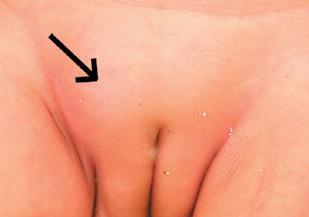An inguinal hernia is a protrusion of some of the contents of the tummy into the groin area. It is a common problem, particularly in boys, as there is an area of weakness or passage-way which originally allowed the testis to descend from the back of the tummy cavity into the scrotum. If this passage stays open, a loop of bowel can pass from the tummy cavity into the groin and sometimes even down to the scrotum. This is painful for the child and can damage both the testis and the bowel. In girls, a hernia may contain one of the ovaries and this may also be damaged whilst inside the hernia. An inguinal hernia should therefore always be repaired once it has been diagnosed, especially in children less than 12 months of age when the risk of the hernia becoming stuck is highest..

The aim of the procedure is removal of the communication from the tummy cavity into the groin area. Unlike the operation in adults, there is usually no need to repair weak muscle tissue or use artificial mesh material. The operation is performed as a day-case under general anaesthesia. Generally the operation takes about 40 minutes.
PREPARATIONS
ANAESTHESIA
You and your child will meet the anaesthetist on the morning of the procedure. After talking to you and briefly examining your child, they will take you through to the operating theatre. One parent is welcome to accompany your child until they are asleep. The anaesthetist puts your child to sleep via a face mask (with children 5 years and over there is the option of either a face mask or a needle with numbing cream). You will then be shown the waiting room where there is tea, coffee or chilled water available to drink.
Once your child is asleep, the anaesthetist will insert a ‘drip’ to allow fluids to be given directly into a vein. Usually this is located in the hand or arm, but occasionally may need to be sited in the leg or scalp.
PROCEDURE
In girls, the ovary may need to be pushed back into the tummy cavity before this step is performed. The wound is then closed with dissolving stitches which are buried under the skin. A clear, water resistant dressing is then placed over the wound.
INITIAL RECOVERY
As a result of the local anaesthetic nerve block, your child may complain of a numb sensation in the groin and in some cases some weakness in the leg on the side of the surgery. This is temporary and will generally settle within a day or so of the operation.
As a result of the local anaesthetic nerve block, your child may complain of a numb sensation in the groin and in some cases some weakness in the leg on the side of the surgery. This is temporary and will generally settle within a day or so of the operation.
POST-OPERATIVE COURSE
Your child should not be bathed on the first night, but nappies can be changed as required and a ‘wetwipe’ of similar cloth used. Showers are safe from the next day onwards. There may be a small amount of blood that oozes from the wound under the dressing in the first 24 hours. Generally the dressing does not need to be changed, but if you are concerned please discuss with your local doctor or myself.
It is quite normal in boys for the scrotum and testis to swell after the operation and there may also be some bruising. Similarly in girls the labia may swell and show evidence of bruising. You should remove the dressing completely after a long bath on the fifth day after the operation. No further dressings are then required. Your child can begin eating when they get home. Start with clear liquids (apple juice, iceblocks) and add solid food slowly and in small amounts. Your child may vomit from the anaesthesia on the day of surgery. This should stop by the morning after surgery.
Your child can begin eating when he gets home. Start with clear liquids (apple juice, iceblocks) and add solid food slowly and in small amounts. Your child may vomit from the anaesthesia on the day of surgery. This should stop by the morning after surgery.
RETURN TO ACTIVITY
- You see any signs of infection: redness along the incision site, increased swelling, foul smelling discharge from incision
- Your child’s pain gets worse or is not relieved by painkillers
- There is bleeding (small ooze of blood in the first day or two is normal)
- Your child has a high temperature
- Vomiting continues on the day after surgery
- You have any questions or concerns
Follow up 4-6 weeks after surgery.
Follow-up
Normally I see you and your child about 3 to 6 weeks following surgery. This is both to ensure that the wound has healed and that you and your child are satisfied with the results of the operation. For patients from rural areas, this review may be deferred to your own general practitioner if you prefer. Please ring soon after the operation to book the post operative appointment to arrange a convenient time.
Problems & further surgery
Generally this procedure is straightforward, but there is a 1% chance that the hernia may not resolve completely following the surgery. In this situation a further operation will be required. During the operation there is a very small risk (less than 1%) of damage to the blood vessels to the testis or the sperm tube in boys and the ovary in girls. This risk is minimised by the use of magnification during the procedure and usually can be both detected and repaired at the time of operation should this occur. As with any surgical procedure, there is always a 2-3% risk of a wound infection or bleeding after surgery..
